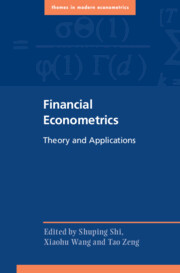Book contents
- Frontmatter
- Contents
- List of Contributors
- Foreword
- Acknowledgments
- Part I Trend Determination, Asset Price Bubbles, and Factor-Augmented Regressions
- Part II Continuous-Time Models and High-Frequency Financial Econometrics
- 4 Finite Sample Theory in Continuous-Time Models
- 5 Infill Asymptotic Theory and Applications in Financial Econometrics
- 6 Econometric Analysis of Nonstationary Continuous-Time Models
- 7 Fractional Brownian Motions in Financial Econometrics
- 8 Estimation of Integrated Covariance Matrix Using High-Frequency Data with Applications in Portfolio Choice
- Part III Bayesian Estimation and Inferences
- Index
4 - Finite Sample Theory in Continuous-Time Models
from Part II - Continuous-Time Models and High-Frequency Financial Econometrics
Published online by Cambridge University Press: 20 February 2025
- Frontmatter
- Contents
- List of Contributors
- Foreword
- Acknowledgments
- Part I Trend Determination, Asset Price Bubbles, and Factor-Augmented Regressions
- Part II Continuous-Time Models and High-Frequency Financial Econometrics
- 4 Finite Sample Theory in Continuous-Time Models
- 5 Infill Asymptotic Theory and Applications in Financial Econometrics
- 6 Econometric Analysis of Nonstationary Continuous-Time Models
- 7 Fractional Brownian Motions in Financial Econometrics
- 8 Estimation of Integrated Covariance Matrix Using High-Frequency Data with Applications in Portfolio Choice
- Part III Bayesian Estimation and Inferences
- Index
Summary
Continuous-time models have found broad applications in many core areas of economics and finance. This chapter first briefly introduces the applications of the continuous-time models for modeling the dynamics of the short-term interest rates. While many estimation methods have been proposed to estimate continuous-time models with discrete samples over the past 40 years, almost all suffer from finite-sample bias. The bias problem is particularly severe for the mean-reversion parameter, which measures the persistence level of the interest-rate process. Moreover, such bias propagates and leads to considerable bias in price calculations of the interest-rate contingent claims, such as bonds and bond options. The focus of this chapter is to give a detailed review of the bias issue. Two bias-correction methods are discussed: the jackknife method and the indirect inference method, which can effectively reduce the estimation bias of the mean-reversion parameter and the bias in pricing contingent claims. Monte Carlo studies are provided to illustrate the characteristics of the bias and investigate the performance of the two bias-correction methods.
Keywords
- Type
- Chapter
- Information
- Financial EconometricsTheory and Applications, pp. 97 - 131Publisher: Cambridge University PressPrint publication year: 2025

